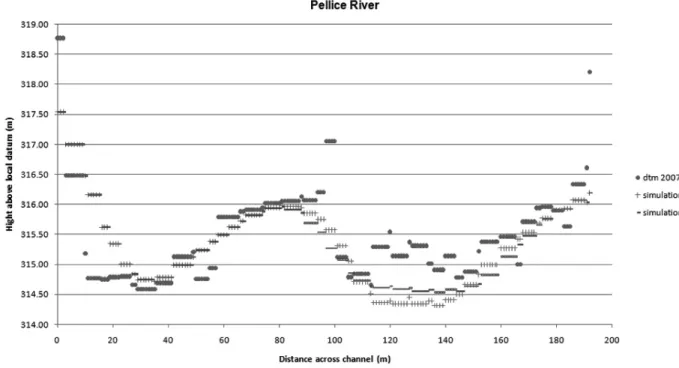See discussions, stats, and author profiles for this publication at: http://www.researchgate.net/publication/251231316
Application of cellular automaton model for
river morphological studies: CAESAR and the
Pellice River (Piedmont, Italy)
CONFERENCE PAPER · JANUARY 2010 CITATIONS2
DOWNLOADS118
VIEWS74
3 AUTHORS, INCLUDING: Chiara Audisio Città Metropolitana di Torino 27 PUBLICATIONS 51 CITATIONS SEE PROFILE Antonio Pasculli Università degli Studi G. d'Annunzio Chieti … 46 PUBLICATIONS 63 CITATIONS SEE PROFILE Available from: Chiara Audisio Retrieved on: 19 August 2015CONGRESSO SGI - ABSTACTS
1 Key words: cellular automaton model, CAESAR, morphological
changes, Piedmont, Italy.
INTRODUCTION
The cellular automaton concept is based on the continued interaction of a series of local process “rules” that governs the behavior of the entire system (WOLFRAM, 1983).
In the geomorphological contest, the basic principles of cellular modeling are that landforms are represented by a lattice of cells and that the interactions between cells (routing of water and sediment for rivers) are treated using simple rules based on abstractions of the governing physics (NICHOLAS, 2005).
The first models used in the river geomorphological contest were applied to the braided river modeling (MURRAY & PAOLA, 1994). Then, other studies have followed, always in the river dynamic contest, also considering alluvial fans and artificial channels (COULTHARD et alii, 2002; THOMAS & NICHOLAS, 2002).
CAESAR, Cellular Automaton Evolutionary Slope And River model, is a open source cellular model which can be run in two modes: a catchment mode with no external influxes other than rainfall; and a reach mode with one or more points through which sediment and water enter to the system (VAN DE WIEL et alii, 2007). The CAESAR model employs a scanning algorithm that “pushes” water across a grid to the cells in front, along four directions (fig. 1; COULTHARD et alii, 2002 and COULTHARD et alii, 2007). This overcomes some problem for braided and meandering river.
The bed-load transport can be calculated with WILCOCK & CROWE (2003) or EINSTEIN (1950) formula.
The cellular model was applied on some part of Pellice River, a Po River tributaries, characterized by a 905 km2 wide drainage basin.
CASE STUDY: PELLICE RIVER
The Pellice river is characterized by a single and multi-thread pattern: wandering in the upper part and meandering in the lower, near the Po river confluence. The river can be considered a cobble – gravel bed in the upper part and a gravel – sand bed in the lower, near the confluence.
The geomorphological characteristics were analyzed by in-depth studies on the planimetric variation occurred in the last one hundred and fifty years. The studies were conducted using historical maps (1880-1945) and aerophotographs (1945-1999).
The CAESAR simulations in reach mode request a digital terrain model (DTM), hydrometric and discharge data and granulometric data. The DTM has been obtained by a LiDAR survey made on February 2007, the hydrometric data have been acquired from both the Hydrological Annals and the regional
Application of cellular automaton model for river morphological
studies: CAESAR and the Pellice River (Piedmont, Italy)
ANTONIO PASCULLI (*), CHIARA AUDISIO (**)(°) & GIORGIO LOLLINO (***) ANTONIO PASCULLI (*), CHIARA AUDISIO (**)(°) & GIORGIO LOLLINO (***)
_________________________
(*) Department of Science, Università degli Studi “G. d’Annunzio” di Chieti-Pescara, [email protected]
(**) (°) CNR-IRPI U.O.S. di Torino, [email protected] (***) CNR-IRPI U.O.S. di Torino, [email protected]
This research began in the context of a PhD in collaboration with the Department of Science of Chieti University and then in the context of PRIN 2007 “Present evolutionary trends and possible future dynamics of alluvial channels in Northern and Central Italy” (national co-ordinator: Dr Nicola Surian, University of Padua; local co-ordinator: Ing. Giorgio Lollino, CNR-IRPI of Turin) with the economic contribution of Research and University Minister.
Fig. 1– Schematic representation of the scanning algorithm of CAESAR (COULTHARD et alii, 2002)
CONGRESSO SGI - ABSTRACTS
2 hydrometric service (ARPA Piemonte, the local district Environmental Protection Agency ). The granulometric data were measured thanks a field survey during the 2008 summer.
Then, a census of the civil and engineering defense has been done. The census has done both by field survey and archive investigation.
The simulations have been done on a two-three kilometers long river reach for a period of one year. The hydrometric data are the measured value at one of the water gauge in the basin (about 6 km up-stream). The erosion method use Einstein formula, because the granulometric characteristics of the reach. Velocity was fixed 3 m/s. the maximum erodible limit was 0.01m. The first results point out fifty cm – one hundred cm variation of the section due to both erosion and deposit phenomena (fig. 2).
REFERENCES
COULTHARD T.J., MACKLIN M.G. &, KIRBY M.J. (2002) - A Cellular Model Of Holocene Upland River Basin And Alluvial Fan Evolution. Earth Surf. Proc. Land., 27, 269-288. COULTHARD T.J., HICKS D.M., VAN DE WIEL M.J. (2007) -
Cellular modelling of river catchments and reaches: advantages, limitations and prospects. Geomorphology, 90, 192-207.
EINSTEIN H.A. (1950) - The bed-load function for sediment
transport on open channel flows. Technical Bulletin USDA, Soil Conservation Service, 1026, 71.
MURRAY A.B. & PAOLA C. (1994) - A cellular model of braided rivers. Nature, 371, 54-57.
NICHOLAS A. P. (2005) - Cellular modelling in fluvial geomorphology. Earth Surf. Proc. Land., 30, 645-649. THOMAS R. & NICHOLAS A.P. (2002) - Simulation of braided
river flow using a new cellular routing scheme. Geomorphology, 43, 179-195.
VAN DE WIEL M.J., COULTHARD T.J., MACKLIN M.G., LEWIN J. (2007) - Embedding reach-scale fluvial dynamics within the CAESAR cellular automaton landscape evolution model. Geomorphology, 90, 283-301.
WILCOCK P.R. & CROWE J.C. (2003) - Surface-based transport model for mixed-size sediment. J. Hydraul. Eng.-ASCE, 129(2), 120-128.
WOLFRAM S. (1983) - Statistical Mechanics of Cellular Automata. Rev. Mod. Phys., 55, 601-644.
Fig. 2 – Schematic cross-section along one of the studied Pellice River reach. In blue the original DTM, in green and red two different simulation: number one

